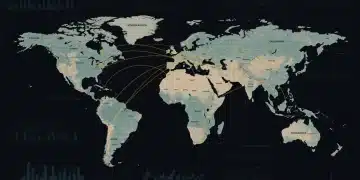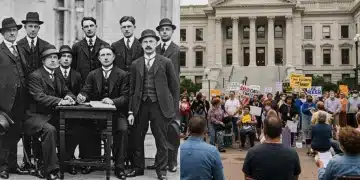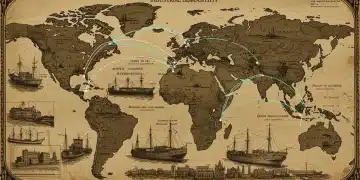The Legacy of World War II: Reshaping US Global Role by 2025

World War II irrevocably shifted the United States from an isolationist power to a global hegemon, establishing foundational international institutions and alliances that still define its foreign policy and global influence as of 2025.
As we approach 2025, the profound impact of The Legacy of World War II: How It Reshaped the US Role in Global Affairs and What It Means for 2025 remains a critical lens through which to understand contemporary international relations. How did a conflict spanning nearly a decade fundamentally alter America’s global trajectory, and what enduring lessons continue to shape its foreign policy decisions today?
The Pivotal Shift: From Isolationism to Global Leadership
Before World War II, the United States largely adhered to an isolationist foreign policy, preferring to avoid entanglement in European conflicts. The attack on Pearl Harbor, however, irrevocably shattered this stance, propelling the nation onto the global stage. This marked a profound ideological and practical shift, committing the US to international engagement and collective security.
The war’s conclusion left much of Europe and Asia devastated, creating a power vacuum that the US, with its intact industrial capacity and burgeoning economic strength, was uniquely positioned to fill. This period saw the rapid expansion of American influence and the establishment of a new global order, largely orchestrated by Washington.
Emergence as a Superpower
The sheer scale of American involvement in World War II, both militarily and economically, solidified its position as a global superpower. This status was not merely about military might but also about economic dominance and ideological leadership, particularly in promoting democracy and free markets.
- Economic Dominance: The US emerged with its industrial base stronger than ever, fueling post-war reconstruction efforts and global trade.
- Military Power: Development of advanced weaponry and a two-ocean navy established unparalleled military projection capabilities.
- Ideological Influence: Promotion of democratic values and capitalist systems became a cornerstone of US foreign policy.
Establishing the Post-War International Order
The aftermath of World War II was not just about military victory; it was about building a new world. The United States played a central role in designing and implementing a framework for international cooperation, aiming to prevent future global conflicts. This proactive approach contrasted sharply with its post-World War I retreat.
Key institutions like the United Nations and the Bretton Woods system (including the International Monetary Fund and the World Bank) were direct results of American leadership, designed to foster economic stability and collective security. These structures laid the groundwork for decades of international relations.
The Genesis of Global Institutions
The US recognized that lasting peace required more than just military victory; it needed robust international mechanisms. The creation of these bodies reflected a strategic vision for a more integrated and stable global community, with the US as a primary architect and guarantor.
- United Nations (UN): Established to maintain international peace and security, promote human rights, and foster social and economic development.
- International Monetary Fund (IMF): Designed to ensure global monetary cooperation and financial stability.
- World Bank: Focused on providing financial and technical assistance to developing countries worldwide.
The Cold War and the Bipolar World Order

Almost immediately following World War II, the ideological chasm between the United States and the Soviet Union led to the Cold War. This period defined US foreign policy for over four decades, transforming its global role into that of the leader of the Western bloc, committed to containing communism.
The US implemented strategies like the Truman Doctrine, the Marshall Plan, and the formation of NATO, all aimed at bolstering allies and countering Soviet expansion. This era solidified the US as a global military and political leader, deeply intertwined with the security and economic well-being of numerous nations.
Containment and Alliance Building
The policy of containment became the overarching strategy, necessitating a vast network of alliances and military bases worldwide. This was a direct legacy of the war, as the US sought to prevent a repeat of unchecked aggression and ideological expansion.
The formation of NATO in 1949, for instance, created a collective defense agreement that remains a cornerstone of transatlantic security. Similarly, treaties with Japan, South Korea, and other nations established a robust security architecture in Asia.
Economic Hegemony and the Dollar’s Dominance
World War II left the US economy virtually untouched by direct conflict, allowing it to flourish while others rebuilt. This economic strength translated into global financial leadership, with the US dollar becoming the world’s primary reserve currency, a status largely cemented by the Bretton Woods Agreement.
This economic power enabled the US to fund recovery efforts in Europe and Asia, further integrating these economies into a US-led capitalist system. The sheer volume of American production and consumption shaped global markets and trade patterns for decades, influencing everything from manufacturing to technological innovation.
The Marshall Plan’s Enduring Impact
The Marshall Plan, officially the European Recovery Program, channeled billions of dollars into rebuilding Western Europe. While ostensibly humanitarian, it was also a strategic move to prevent the spread of communism and create strong trading partners for the US.
- European Reconstruction: Rapid economic recovery in war-torn nations.
- Market Expansion: Created robust markets for American goods and services.
- Political Stability: Helped stabilize democracies and counter communist influence.
Human Rights and the Moral Dimension of US Foreign Policy
The atrocities of World War II, particularly the Holocaust, deeply influenced the post-war emphasis on human rights. The US, in its renewed global role, became a prominent advocate for universal human rights, though its record has been subject to scrutiny over time.
The Universal Declaration of Human Rights, adopted by the UN in 1948, reflected a global consensus, heavily influenced by Western thought, on fundamental human dignity. This moral dimension, while sometimes inconsistently applied, became an integral part of how the US articulated its global leadership.
Promoting Democratic Values
The fight against fascism and totalitarianism during the war reinforced the American commitment to democratic governance. Post-war efforts often linked economic aid and security assistance to the promotion of democratic institutions, though this approach also faced geopolitical complexities.
The US continues to champion human rights and democratic principles on the international stage, often using its diplomatic and economic leverage to pressure nations on these issues. This advocacy is a direct outgrowth of the moral imperatives that emerged from the horrors of World War II.
The Legacy’s Echo in 2025: Navigating a Multipolar World
As we look towards 2025, the foundational changes initiated by World War II continue to shape the US role in global affairs, albeit in an evolving landscape. The unipolar moment after the Cold War has given way to a more multipolar world, with rising powers challenging traditional US dominance.
The institutions and alliances forged in the post-WWII era, such as NATO and the UN, remain vital but face new pressures from geopolitical shifts, technological advancements, and emerging threats like climate change and cyber warfare. The US must adapt its leadership to these complex realities, balancing historical commitments with contemporary challenges.
Adapting to New Geopolitical Realities
The US is currently navigating a period of significant geopolitical flux, marked by renewed great power competition and the need for flexible diplomatic engagement. The principles of collective security and economic interdependence, born from WWII, are being tested and reinterpreted.
- Great Power Competition: Managing relations with China and Russia, who present significant economic and military challenges.
- Transnational Threats: Addressing issues like climate change, pandemics, and terrorism that require global cooperation.
- Alliance Reassessment: Strengthening existing alliances while exploring new partnerships to address shared interests.
| Key Aspect | Brief Description |
|---|---|
| Global Leadership Shift | WWII moved the US from isolationism to a dominant global power, establishing its enduring international role. |
| Institutional Creation | US spearheaded the formation of UN, IMF, and World Bank, shaping post-war international governance. |
| Cold War Dynamics | The conflict led to a bipolar world, with the US leading the Western bloc against Soviet communism. |
| Economic Dominance | Post-WWII, the US economy and dollar became global pillars, driving reconstruction and trade. |
Frequently Asked Questions About WWII’s US Global Impact
World War II decisively ended US isolationism by demonstrating that global events directly impacted American security and prosperity. The attack on Pearl Harbor and the subsequent need for global alliances forced the US to embrace a proactive international role, leading to its leadership in establishing a new world order.
Under US leadership, key international institutions like the United Nations (UN), the International Monetary Fund (IMF), and the World Bank were established. These organizations aimed to promote collective security, economic stability, and international cooperation, forming the bedrock of the post-war global governance structure.
The Cold War cemented the US’s role as a global superpower and leader of the Western bloc. It necessitated the policy of containment against communism, leading to the formation of military alliances like NATO and extensive economic aid programs such as the Marshall Plan, deeply entrenching US global involvement.
Economically, WWII positioned the US as the world’s leading economic power, with the dollar becoming the primary global reserve currency. Its intact industrial base and financial strength enabled it to spearhead global reconstruction, integrating other economies into a US-led capitalist system that persists today.
In 2025, WWII’s legacy means the US continues to navigate a complex global landscape defined by institutions and alliances it helped create. It faces challenges from rising powers and transnational threats, requiring it to adapt its leadership while upholding principles of collective security and economic interdependence established post-war.
Looking Ahead: Impact and Implications
As 2025 unfolds, the United States continues to navigate global dynamics heavily shaped by the legacy of World War II. The diplomatic architecture built in the aftermath of World War II remains a core pillar of international cooperation, even as new geopolitical pressures challenge its relevance. Historical analysis, such as the one provided by the Imperial War Museums on how World War II reshaped modern global order (https://www.iwm.org.uk/history/how-the-legacy-of-the-second-world-war-shaped-the-modern-world), reinforces how deeply today’s alliances and security doctrines are rooted in that era.
Despite evolving threats, Washington’s approach still draws legitimacy and strategic direction from its World War II heritage, especially in strengthening alliances and shaping collective defense initiatives. The real test now lies in whether the United States can innovate within that framework, using lessons from World War II while adapting to modern realities like digital warfare, economic influence, and transnational instability. Successfully merging historical legacy with forward-looking policy will determine its ability to sustain leadership and maintain global stability in the years ahead.





